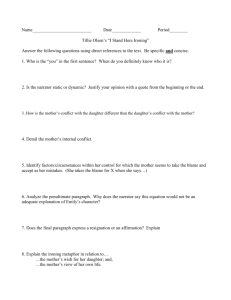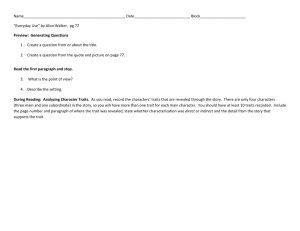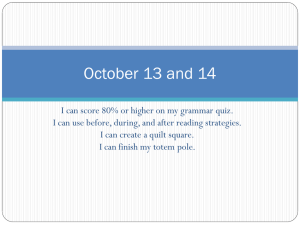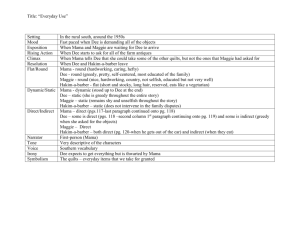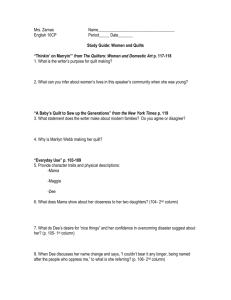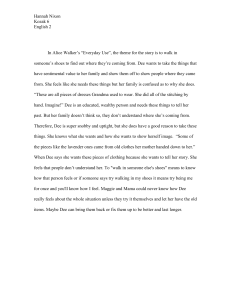The Relationships of Mothers and Daughters
advertisement
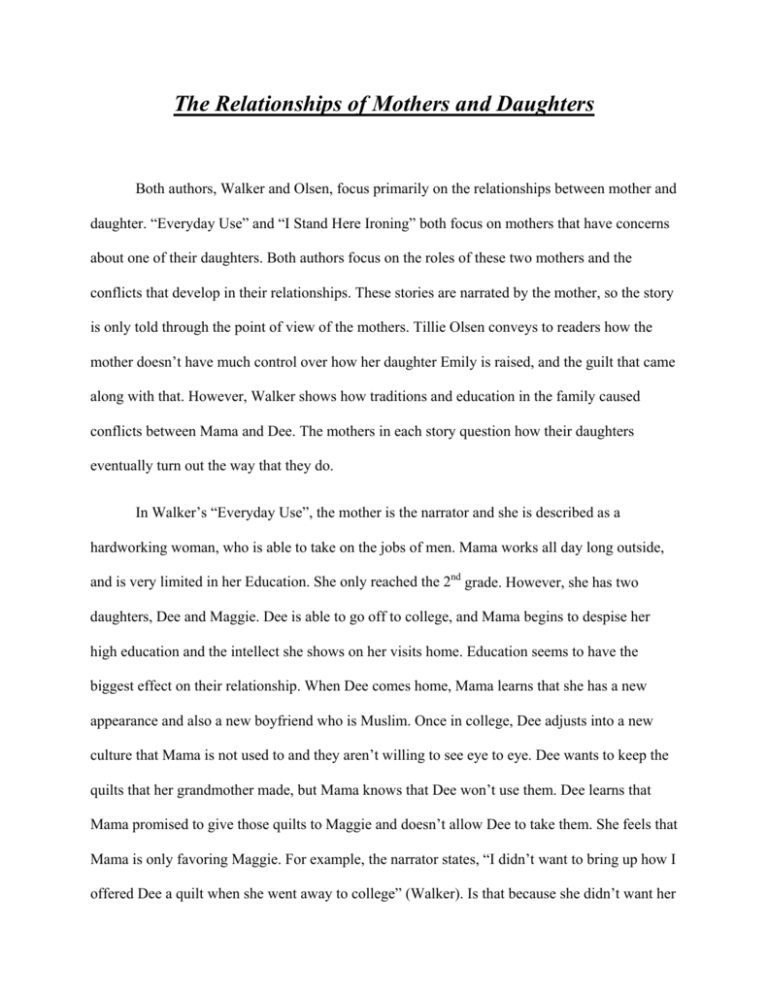
The Relationships of Mothers and Daughters Both authors, Walker and Olsen, focus primarily on the relationships between mother and daughter. “Everyday Use” and “I Stand Here Ironing” both focus on mothers that have concerns about one of their daughters. Both authors focus on the roles of these two mothers and the conflicts that develop in their relationships. These stories are narrated by the mother, so the story is only told through the point of view of the mothers. Tillie Olsen conveys to readers how the mother doesn’t have much control over how her daughter Emily is raised, and the guilt that came along with that. However, Walker shows how traditions and education in the family caused conflicts between Mama and Dee. The mothers in each story question how their daughters eventually turn out the way that they do. In Walker’s “Everyday Use”, the mother is the narrator and she is described as a hardworking woman, who is able to take on the jobs of men. Mama works all day long outside, and is very limited in her Education. She only reached the 2nd grade. However, she has two daughters, Dee and Maggie. Dee is able to go off to college, and Mama begins to despise her high education and the intellect she shows on her visits home. Education seems to have the biggest effect on their relationship. When Dee comes home, Mama learns that she has a new appearance and also a new boyfriend who is Muslim. Once in college, Dee adjusts into a new culture that Mama is not used to and they aren’t willing to see eye to eye. Dee wants to keep the quilts that her grandmother made, but Mama knows that Dee won’t use them. Dee learns that Mama promised to give those quilts to Maggie and doesn’t allow Dee to take them. She feels that Mama is only favoring Maggie. For example, the narrator states, “I didn’t want to bring up how I offered Dee a quilt when she went away to college” (Walker). Is that because she didn’t want her “favorite”, Maggie, to overhear her? She eventually states that she wanted to promise those quilts for Maggie when she gets married. This makes the reader question if that’s really the truth, or if she is just purposely trying to keep the quilts away from Dee so they will not be misused. She eventually states “It was Grandma Dee and Big Dee who taught her (Dee) how to quilt herself…She looked at her sister with something like fear but she wasn’t mad at her” (Walker). This shows the readers an evolving conflicted relationship between Mama and Dee, since she has left for school. It also appears that Mama favors Maggie over Dee, without a doubt. Favoritism caused a conflict between the two, but higher education and college experiences separated their views and mentality. Dee lived a completely different lifestyle than Mama ever did and she was opposite of Maggie, which may also explain why the two never seen eye to eye in their relationship. Dee states that Mama doesn’t understand her heritage and says to Maggie, “You ought to try to make something of yourself, too, Maggie. It’s really a new day for us. But from the way you and Mama still live you’d never know it” (Walker). This also shows that Dee only despises her mother, but can still see the innocence within Maggie. Mama has concerns for Dee’s new culture and questions how she has become the way she is. Similarly, the narrator in “I Stand Here Ironing” has a similar concern for her daughter also. Tillie Olsen’s “I Stand Here Ironing”, took place during the Great Depression in the 1930’s. An unnamed narrator tells the story of raising her daughter, Emily, through her point of view and talks about the concerns of how she grew up. In the beginning of the story, there is an unknown person speaking to the narrator so they can help her daughter. The reader, however, is unable to get a sense of who this person could be or what they are calling in relevance to. Who is this person speaking to the narrator? What does Emily need help for? I believe Olsen makes the unknown person and situation questionable so there is more focus on the narrator’s response. This could be for readers to get an idea of what type of mother she may be, regardless of who she is speaking to about her daughter. While the narrator wonders what she can do to help, she realizes she can’t help because she only has so much insight on her daughter. As a struggling single parent, the narrator leaves Emily in the care of a close neighbor. She eventually places Emily in daycare at the age of two when she has to take work long hours at work every day. The narrator also has four other children, but doesn’t speak much about them. She seems to be more joyful around them, rather than somber with Emily. For example, a neighbor states, “You should smile at Emily more when you look at her.” (Olsen). This gives the reader a sense that the narrator doesn’t show much affection toward Emily as a child. The narrator even comments to herself, “I loved her. There were all the acts of love.” (Olsen). This proves that the narrator becomes naïve and doesn’t understand how she may come off to Emily as a parent. The narrator wasn’t able to give Emily as much care as she desired to, and that gave her a sense of guilt. For example, she ends up remarrying and having another child, Susan. The narrator’s husband tends to leave Emily alone by herself, and she eventually became very weak and sick while the narrator was in the hospital giving birth. At a later point in life, she also suffered from tuberculosis at a convalescent home. These acts convey the guilt that was placed on the mother, and how it might have affected the relationship with Emily. Despite those struggles, the narrator eventually realized her daughter had a great sense of humor that was applaudable and wanted to encourage her to use her talent. She stated, “Why don’t you do something like this in the school amateur show?” (Olsen). Once Emily won the talent show, she called her mother with the great news and she ends up performing more often. This ending to the story makes readers question how someone can grow up with so many hardships, but still manage to make others laugh and smile. And although the narrator is proud of her daughter, she knew that the life her daughter lived did not explain her sense of humor. How did her sense of humor and talent come about? Both stories show the concerns within each relationship between mother and daughter. These authors show that although a mother can be in their daughter’s life, they can’t always control how their daughters turn out different from what they expected. In “Everyday Use”, it was obvious that Dee turned out different than Mama expected, due to an education and experiencing life in different times. However, in “I Stand Here Ironing” it is unclear as to why Emily becomes so humorous and talented, despite her childhood. It also never explained as to how this happened. Although the relationships are based on different events, it just shows the same point that mothers may not always have control over their daughters’ destiny as much as they think they can, whether it’s positive or negative outcomes. Works Cited Olsen, Tillie. "SparkNotes: I Stand Here Ironing." SparkNotes: Today's Most Popular Study Guides. N.p., n.d. Web. 11 Mar. 2013. <http://www.sparknotes.com/short-stories/i-stand-hereironing/>. Olsen, Tillie. I stand here ironing. Cambridge: ProQuest Information and Learning, 2002. Print. Walker, Alice, and Barbara Christian. Everyday use. New Brunswick, N.J.: Rutgers University Press, 1994. Print. Walker, Alice . "SparkNotes: Everyday Use." SparkNotes: Today's Most Popular Study Guides. N.p., n.d. Web. 5 Mar. 2013. <http://www.sparknotes.com/short-stories/everyday-use/>.
